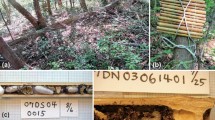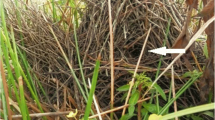In a study carried out with the trap-nesting solitary wasp Trypoxylon attenuatum (Hymenoptera: Crabronidae) in 2000, we analysed the significance of different nest characteristics, like the vestibular cell and empty intercalary cells, and its role in the reduction of mortality. Analysis of the presence of the vestibular cell suggested that it represents a nest completion structure, whose presence reduces mortality in the initial stages (M1) but does not affect that due to chrysidid parasitoids (MP). The length of such vestibular cell was found to depend mainly on the space between the last provisioned cell and the exterior, pointing to a possible role in the reduction of the remaining space that could be used by other females to establish a nest exterior to the completed one. The empty intercalary cells were smaller than the vestibular cells, did not affect M1 or MP mortality rates in the nest, and exhibited an “aggregated” pattern of occurrence. This suggests that they could be the result of “abnormal” behaviour by the female owning the nest. The total mortality rate decreased with the increase in the number of cells in the nests, also being greater in nests established at low heights above the ground. M1 was lower in the innermost cells, while MP increased towards the interior and in the nests with more cells. The distribution in the nests of cells parasitized by Trichrysis cyanea (the main natural enemy found in the wasp population studied) reflects an “aggregated” pattern, suggesting repeated attacks against certain nests.


Similar content being viewed by others
REFERENCES
Abraham, R. (1982). Zur Biologie von Trypoxylon attenuatum Smith, 1851 und T. figulus (Linnaeus, 1758) (Hymenoptera: Sphecidae). Entomol. Mitt. 114: 137–147.
Antropov, A. V. (2001). Tribe des Trypoxylini. In Bitsch, J. (coord), Hyménoptères Sphecidae d'Europe Occidentale (Vol. 3, Faune de France 86). Fédération Française des Sociétés des Sciences Naturelles, Paris, pp. 347–384.
Asís, J. D., Gayubo, S. F., and Tormos, J. (1994). Biological observations on Trypoxylon attenuatum and description of its mature larva and its natural enemy Trichrysis cyanea (Hymenoptera: Sphecidae, Chrysididae). J. Kansas Entomol. Soc. 67: 199–207.
Assis, J. M. F., and Camillo, E. (1997). Diversidade, sazonalidade e aspectos biologicos de vespas solitarias (Hymenoptera: Sphecidae, Vespidae) em ninhos armadilhas na Região de Ituiutaba, MG. An. Soc. Entomol. Bras. 26: 335–347.
Bohart, R. M., and Menke, A. S. (1976). Sphecid Wasps of the World. A Generic Revision. University of California Press, Berkeley.
Camillo, E. (2005). Nesting biology of four Tetrapedia species in trap-nests (Hymenoptera: Apidae: Tetrapediini). Rev. Biol. Trop. 53: 175–186.
Camillo, E., Garófalo, C. A., Muccillo, G., and Serrano, J. C. (1993). Biological observations on Trypoxylon (Trypargilum) lactitarse saussure in Southeastern Brazil (Hymenoptera, Sphecidae). Rev. Bras.Entomol. 37: 769–778.
Camillo, E., Garófalo, C. A., and Serrano, J. C. (1994). Observaçoes sobre a biologia de Trypoxylon (Trypargilum) rogenhoferi Kohl (Hymenoptera: Sphecidae). An. Soc. Entomol. Bras. 23: 299–310.
Coville, R. E. (1982). Wasps of the Genus Trypoxylon Subgenus Trypargilum in North America (Hymenoptera: Sphecidae). University of California Press, Berkeley.
Coville, R. E., and Coville, P. L. (1980). Nesting biology and male behavior of Trypoxylon (Trypargilum) tenoctitlan in Costa Rica (Hymenoptera: Sphecidae). Ann. Entomol. Soc. Amer. 73: 110–119.
Coville, R. E., and Griswold, C. (1983). Nesting biology of Trypoxylon xanthandrum in Costa Rica with observations on its spider prey (Hymenoptera: Sphecidae; Araneae: Senoculidae). J. Kans. Entomol. Soc. 56: 205–216.
Coville, R. E., and Griswold, C. (1984). Biology of Trypoxylon (Trypargilum) superbum (Hymenoptera: Sphecidae), a spider-hunting wasp with extended guarding on the brood by males. J. Kans. Entomol. Soc. 57: 365–376.
Danks, H. V. (1970). Biology of some stem-nesting aculeate Hymenoptera. Trans. R. entomol. Soc. Lond. 122: 323–395.
Danks, H. V. (1971). Populations and nesting-sites of some aculeate Hymenoptera nesting in Rubus. J. Anim. Ecol. 40: 63–77.
Evans, H. E., and O'Neill, K. M. (1988). The Natural History and Behavior of North American Beewolves. Comstock Publishing Associates, Ithaca.
Evans, H. E., and West Eberhard, M. J. (1970). The Wasps. University of Michigan Press, Ann Arbor.
Freeman, P. (1938). Notes on the nesting of five species of solitary wasps (Hymenoptera, Sphecoidea). Proc. R. Entomol. Soc. Lond. 13: 1–6.
Fye, R. E. (1972). The effect of forest disturbances on populations of wasps and bees in Northwestern Ontario (Hymenoptera: Aculeata). Can. Entomol. 104: 1623–1633.
García, M. V. B., and Adis, J. (1995). Comportamento de nidificação de Trypoxylon (Trypargilum) rogenhoferi Kohl (Hymenoptera, Sphecidae) em una floresta inundável de várzea na Amazônia Central. Amazoniana 18: 259–282.
Grandi, G. (1961). Studi di un Entomologo sugli Imenotteri superiori. Boll. Ist. Entomol. (Bologna) 25: 1–659.
Hamm, A. H., and Richards, O. W. (1930). The biology of the british fossorial wasps of the families Mellinidae, Gorytidae, Philanthidae, Oxybelidae and Trypoxylonidae. Trans. Entomol. Soc. Lond. 78: 95–131.
Hook, A. W., and Matthews, R. W. (1980). Nesting biology of Oxybelus sericeus with a discussion of nest guarding by male sphecid wasps (Hymenoptera). Psyche 87: 21–37.
Jayasingh, D. B., and Taffe, C. A. (1982). The biology of the eumenid mud-wasp Pachodynerus nasidens in trapnests. Ecol. Entomol. 7: 283–289.
Krombein, K. V. (1967). Trap-nesting Wasps and Bees. Life History and Associates. Smithsonian Press, Washington.
Malyshev, S. I. (1936). The nesting habits of solitary bees. Eos 11: 201–309.
Matthews, R. W. (2000). Nesting biology of the stem-nesting wasp Psenulus interstitialis Cameron (Hymenoptera: Crabronidae: Pemphredoninae) on Magnetic Island, Queensland. Austr. J. Entomol. 39: 25–28.
Oku, S., and Nishida, T. (2001). Presence of single-sex broods under local mate competition in Trypoxylon malaisei (Hymenoptera: Sphecidae): adaptation or maladaptation? Ann. Entomol. Soc. Amer. 94: 550–554.
Rosenheim, J. A. (1987). Host location and nest exploitation by the cleptoparasitic wasp Argochrysis armilla: The role of learning (Hymenoptera: Chrysididae). Behav. Ecol. Sociobiol. 21: 401–406.
Rosenheim, J. A. (1989). Behaviorally mediated spatial and temporal refuges from a cleptoparasite, Argochrysis armilla (Hymenoptera: Chrysididae), attacking a ground-nesting wasp, Ammophila dysmica (Hymenoptera: Sphecidae). Behav. Ecol. Sociobiol. 25: 335–348.
Rosenheim, J. A. (1990). Density-dependent parasitism and the evolution of aggregated nesting in the solitary Hymenoptera. Ann. Entomol. Soc. Amer. 83: 277–286.
Rust, R. W. (1986). Biology of Osmia (Osmia) ribifloris Cockerell (Hymenoptera: Megachilidae). J. Kans. Entomol. Soc. 59: 89–94.
Sears, A. L. W., Smiley, J. T., Hilker, M., Müller, F., and Rank, N. E. (2001). Nesting behavior and prey use in two geographycally separated populations of the specialist wasp Symmorphus cristatus (Vespidae: Eumeninae). Amer. Mid. Nat. 145: 233–246.
Seidelmann, K. (1999). The function of the vestibulum in nests of a solitary stem-nesting bee, Osmia rufa (L.). Apidologie 30: 19–29.
Spofford, M. G., Kurczewski, F. E., and Peckham, D. J. (1986). Cleptoparasitism of Tachysphex terminatus (Hymenoptera: Sphecidae) by three species of Miltogrammini (Diptera: Sarcophagidae). Ann. Entomol. Soc. Amer. 79: 350–358.
Strohm, E., Laurien-Kehnen, C., and Bordon, S. (2001). Escape from parasitism: Spatial and temporal strategies of a sphecid wasp against a specialised cuckoo wasp. Oecologia 129: 50–57.
Tepedino, V. J., McDonald, L. L., and Rothwell, R. (1979). Defense against parasitization in mud-nesting Hymenoptera: Can empty cells increase net reproductive output? Behav. Ecol. Sociobiol. 6: 99–104.
Tormos, J., Asís, J. D., Gayubo, S. F., Calvo, J., and Martín, M. A. (2005). Ecology of crabronid wasps found in trap nests from Spain (Hymenoptera: Spheciformes). Fla. Entomol. 88: 278–284.
Vieira de Jesús, B. M., and Garófalo, C. A. (2000). Nesting behaviour of Centris (Heterocentris) analis (Fabricius) in southeastern Brazil (Hymenoptera, Apidae, Centridini). Apidologie 31: 503–515.
Weaving, A. J. S. (1995). A comparison of nesting success and nesting habits in some Afrotropical aculeate wasps, with particular reference to nest parasites (Hymenoptera: Sphecidae, Eumenidae). Ann. Cape Prov. Mus. Nat. Hist. 19: 181–224.
Willmer, P. (1985). Size effects and hygrothermal balance and foraging patterns of a sphecid wasp, Cerceris arenaria. Ecol. Entomol. 10: 469–479.
ACKNOWLEDGMENTS
The manuscript benefited from helpful comments by three anonymous reviewers. This research was supported by funding from the Consejería de Educación y Cultura, Junta de Castilla y León (Project code: SA38/00B).
Author information
Authors and Affiliations
Corresponding author
Rights and permissions
About this article
Cite this article
Asís, J.D., Benéitez, A., Tormos, J. et al. The Significance of the Vestibular Cell in Trap Nesting Wasps (Hymenoptera: Crabronidae): Does its Presence Reduce Mortality?. J Insect Behav 20, 289–305 (2007). https://doi.org/10.1007/s10905-007-9080-5
Revised:
Accepted:
Published:
Issue Date:
DOI: https://doi.org/10.1007/s10905-007-9080-5




